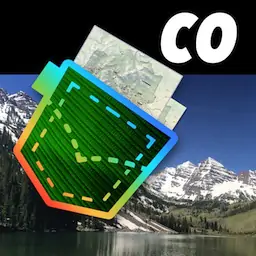"Scenic view from atop Twin Rock" by U.S. National Park Service , public domain
Petrified ForestFlorissant Fossil Beds |
featured in
| National Parks Pocket Maps |  | |
| Colorado Pocket Maps |  |
Florissant Fossil Beds
Petrified Forest
National Park Service
U.S. Department
National
Park Serviceof the Interior
U.S. Department of the Interior
Florissant Fossil Beds
SiteNational
Name and
Designation
Monument
A tall forest grew in the valley behind the visitor center 34 million years ago. Some of the trees survived as
fossils that are visible on the trails today. Scientists have studied Florissant’s fossil wood to understand
changes in climate and forest composition and the process of petrification—turning wood to rock.
Why are only stumps left?
Are there more stumps underground?
Heavy rain or rapid snowmelt can sweep rock and ash from
volcanos into thick mudflows called lahars. Lahars can rush
downslope at up to 120 mi/hr (190 km/hr). One lahar from the
ancient Guffey Volcano flowed through the Florissant stream
valleys 34 million years ago. This volcanic mudflow buried the
forest there under more than 16 ft (5 m) of debris and killed the
trees by preventing oxygen from reaching their roots. The lahar
encased and protected the lower trunks, which are preserved as
fossils. The roots and tops of the trees decayed or broke off.
Researchers have searched for undiscovered stumps at
Florissant in several ways. Ground-penetrating radar, which
measures reflections from electromagnetic pulses, has not been
effective because the upper soil of the park is rich in clay. A
recent study shows promise for detecting stumps with a
magnetometer instead. This is because the local magnetic field is
weaker above the silica-rich stumps than above the surrounding
volcanic rock, which contains the magnetic mineral magnetite.
How does a tree petrify?
Artistic reconstruction of the Eocene forest at Florissant.
What kinds of trees lived here?
Most fossil stumps at Florissant are redwoods similar to the coast
redwoods now living in California and Oregon. Some of the
petrified wood comes from hardwoods, including Hovenia
(related to Japanese raisin trees), Koelreuteria (golden rain tree),
Robinia (locust), Zelkova (related to elms), and Chadronoxylon.
When mineral-rich water penetrates wood, it deposits silica
on the plant cells. As the wood decays and water continues
to seep in, more silica minerals (opal, quartz, and a quartz
with microscopic crystals called chalcedony) form inside the
cells. Most of the silica in the stumps at Florissant probably
came from volcanic rock and ash. Certain types of wood,
like redwood trunks, are more durable than others, which
may make them more likely to petrify. Experiments show
that wood can petrify in tens to
hundreds of years in ideal
conditions, but it likely took
much longer for the stumps at
Florissant to turn into rock.
Some plant tissue remains after
wood petrifies, which helps
preserve the tree structure in
cellular detail like that seen in
this fossil wood of Koelreuteria
(golden rain tree).
Image magnified.
Do the stumps have growth rings?
Scientists cut thin sections of
petrified wood to study growth
rings and other plant features
under a microscope. During
petrification, minerals form in
the spaces of organic tissue. This
process can preserve individual
plant cells.
Some of the petrified redwood stumps at Florissant
show clear growth rings. The Florissant fossil tree
rings are wider than those of modern California
redwoods, indicating a better growing season in the
past. A technique called tree ring cross-dating
matches the patterns of thin and thick rings among
different trunks to see if the trees lived through any of
the same drought or wet periods. Petrified Florissant
trees have the same patterns, so it is likely that all the
trees in the forest died at the same time. A single lahar
probably covered the entire valley in a day.
Colorful Petrified Wood
You can see many colors in the petrified stumps.
Cream-colored fossil wood usually contains
quartz. Dark brown or grey indicates organic
material, often in opal. Iron minerals make other
colors, including black and dull red.
Where can I see petrified stumps?
Big
3 Stump
N
The Ponderosa Loop and Petrified Forest Loop trails
pass more than a dozen petrified stumps (map at left).
Some of the best stumps lie right behind the
visitor center (stop 1). On the Ponderosa Loop
trail, a modern forest surrounds the fossil one, and
living pines grow directly on top of petrified
stumps (stop 2)! The Big Stump (stop 3) on the
Interpretive Pit
(Seasonal Access)
Petrified Forest Loop trail is completely excavated.
The petrified trees are the largest fossils at Florissant.
Please help protect them by staying behind railings.
Law prohibits disturbing or collecting fossils in the
national monument.
Stump
1 Redwood Trio
0
2 Pines
0.1 mi
0.1
3 Big Stump
0.2 km
Petrified Forest Loop
1 mi (1.6 km)
Boulder Creeek Trail
& Hans Loop
Visitor
Center
1
Ponderosa Loop
0.5 mi (0.8 km)
Sawmill Trail
2
Hornbek
Wildlife
Loop
Geologic Trail
Explosive Excavations
Early settlers knew of the stumps near
Florissant, and tourists arrived with the
railroad in 1887. Collectors removed dozens
of exposed stumps by the turn of the century,
sometimes by wagon loads. In the 1920s, two
commercial sites excavated stumps on the
land. One of these private operations used
dynamite, which likely contributed to the
cracks visible in the stumps under the shelters
by the visitor center.


